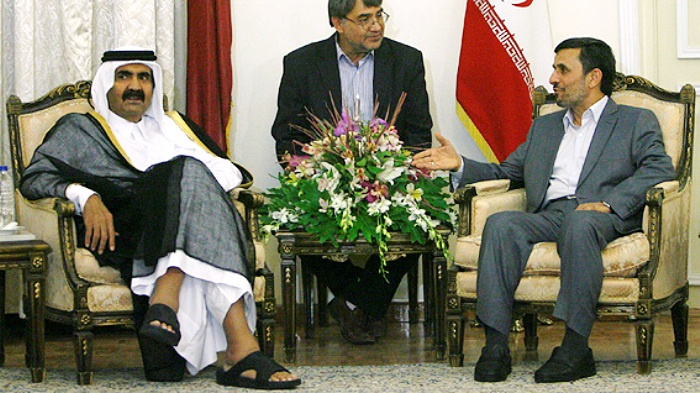Sandals, Sweatshirts and Swedes

Since when did the Iranian media become fixated with diplomatic etiquette, or lack thereof?
One has to sieve through historical documents, perhaps the archives of the Qajars primarily, since it was during the reign of this Turkic dynasty that Iran came into closer contact with global powers of the time, Britain, Russia and France. Iran was an empire in decline at the beginning of the 19th century, unfortunate to deal with powers that were far superior in terms of economy, technology and military. The asymmetrical relation and superpowers' thirst to expand their sphere of influence in the Orient did not leave much room for respect. "For nine years, the government of Russia has taken 900 thousand tomans [equaling 1.8 million pounds] away from me and they have usurped my lands in Yerevan," writes Haji Mirza Aghasi, chancellor to the third Qajar king Mohammad Shah. "The Russian chargé d'affaires has called me thousands of curses that one cannot even say to a coolie," he bitterly recalls.
Iranians were not so much into diplomatic etiquette after the 1979 Islamic Revolution. Defiance against the West and the East, a tenet of the new order, translated into intentional disregard of diplomatic manners. As the revolutionary zeal abated and awareness of international norms increased, they gradually became sensitive to observation of diplomatic etiquette, by the others. Interestingly, when formalities were not observed, they did not blame it on the uncultured foreign official, but rather on the Iranian counterpart, whose attitude was seen as conducive to disrespect.
It was probably Mahmoud Ahmadinejad who brought the issue into the media spotlight in the recent years. In a radio interview during the 2009 presidential campaign, he criticized his predecessor Mohammad Khatami with one of his signature outlandish claims. Referring to Khatami's reception in 2005 by former French President Jacques Chirac in the Élysée Palace he said: "the day the former president visited France … has turned into one of the most bitter days of my life: while Jacques Chirac was standing on the top step, the former president had to get off the car and mount several steps to reach Chirac. What we did came out of a feeling of weakness, and it brought us humiliation."
Reformist media quickly rejected Ahmadinejad's allegation and published photos from the reception ceremony to refute his claims. Unsurprisingly, the pictures showed quite the opposite, that is, a warm welcoming by the French president.
Diplomatic reception turned into a popular meme in the following years. And thus, in every diplomatic meeting of Mahmoud Ahmadinejad, the Reformist media looked for an opportunity to find what he blamed Khatami of. In 2011, the former emir of Qatar Hamad bin Khalifa Al Thani provided them a good chance when he appeared in Tehran with his traditional Arabic custom. His choice of footwear, sandals and no socks, was called an insult by the Reformist and Ahmadinejad-averse conservative media. Media compared the emir's outfit with his garment during visits to the UK and the US in order to prove that he could have dressed more formally during his Iran visit. Fifteenth months later, the freshly-introduced Swedish ambassador to Tehran, Peter Tejler, raised ire among both the Principlists and Reformists, when he sat legs crossed in front of Ahmadinejad after delivering his credentials. Ahmadinejad was of course shrewd enough to reciprocate.
Since June 2013, it is Rouhani and his pro-détente, or in the eyes of Principlists, pro-West, circle, who have become the subject of scrutiny. David Cameron's assertive posture in front of Hassan Rouhani, when the two met on the sidelines of UN General Assembly, raised strong criticism. The hardliner Vatan-e Emrooz daily published a picture on its front page with the headline "Kick of the Fox". The cunning canine, the 'old fox', as Britain is known in the Iranian political jargon, had acted disrespectfully.
It is not only Western or regional leaders whose supposedly disrespectful appearance or posture brings Iranian politicians under criticism. Foreign correspondents interviewing Iranian leaders may also put pressure on them inadvertently. When shawl slipped off the head of Spanish journalist Ana Pastor García during her interview with Mahmoud Ahmadinejad in Tehran, the media called that an insult to the rules of the country and slammed the president for his indifference. Iranian hardliners may be no fan of suits and ties, but they can still criticize Fareed Zakaria for donning a sweatshirt in his interview with Hassan Rouhani and violating the etiquette.
Suspicion towards global powers is deeply entrenched in Iran's foreign doctrine, and nearly four decades of bitter struggle with the West have made it stronger. And with a political culture in which dignity is held so highly, fixation on the issue of formal reception by foreign representatives is understandable. Yet, it should not be taken to the extremes of obsession and insecurity. Today, Iran is far more powerful and confident than it was during the reign of the Qajars and the Pahlavis; hardly one can imagine a local official to be insulted by a foreign ambassador in the crude manner that Haji Mirza Aghasi experienced. Perhaps the time has come to focus attention on more important issues in diplomacy, rather than Fareed Zakaria's sweatshirt.

